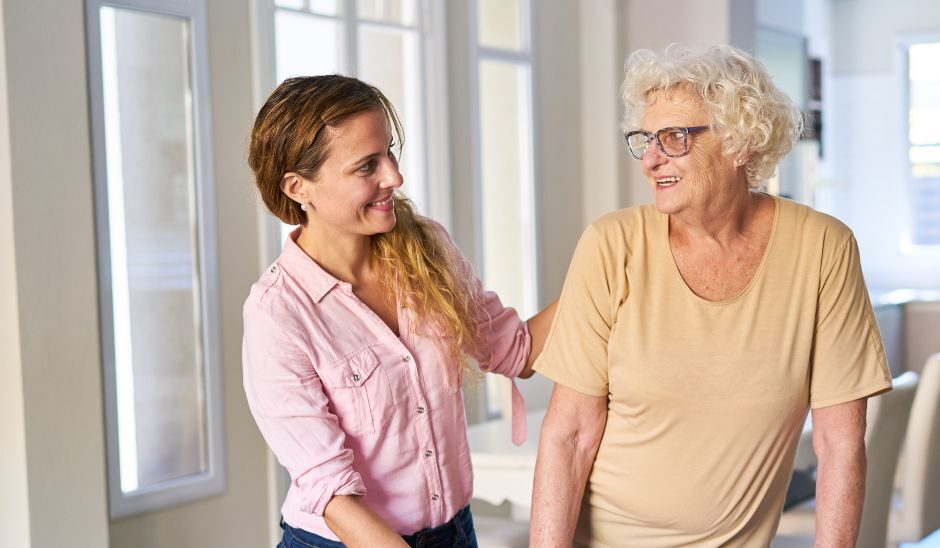Today we are thrilled to have Aging in Place Expert Rosanna Fay here to share some great advice on how to help your loved ones continue living safely in their homes as they age. The CDC defines Aging In Place as “The ability to live in one’s own home and community safely, independently, and comfortably, regardless of age, income, or ability level.” Rosanna has a wealth of knowledge on the subject as she helped her own parents successfully age in place, and has completed a CAPS (certified aging in place specialist) designation program.
Aging in Place: Rights and Wrongs!
I considered titling this post “do’s and don’ts” for successful aging in place, but in revisiting my parents’ experience I was struck by how many potential points of failure exist in an aging in place (AIP) plan. There truly are right and wrong ways to tackle a family strategy.
My parents did stay in their own home until their last breath, but it wasn’t easy and several times the plan almost came undone. Fortunately, they made enough good decisions to allow their success.
WHAT THEY DID RIGHT
One: Type of Home
Once retired, they moved into a new house with a vastly different floor plan and level of functionality. Without question, their home choice was the number one reason they were able to age in place. It had:
- First floor master bedroom; a life saver when they couldn’t do stairs.
- First floor bathroom with a stand up shower; critical when their mobility required a shower chair and handheld shower head.
- First floor laundry area.
- Attached garage; convenient and weather protected.
- Flat exterior landscaping that accommodated their rolling walkers.
Two: Types of in-home solutions
Once moved in, they also secured critical solutions for the house:
- Motorized twin beds provided the same functionality as hospital beds yet still looked pretty. That was important to my mom!
- Motorized lift/recliner chairs supported their fragile knees and balance issues.
- A medical alert system, which was actually a gift to them from their children, was used by each parent at least once.
- On-hand hospital quality products like removable bed rails, portable shower bench and a temporary tub-handle allowed seamless transitions after hospital stays back into their home.
- Check out Home Depot’s Bathroom Safety & Accessibility collection of products.
Three: Choosing an ideal neighborhood
- They chose a housing development full of other seniors. It wasn’t an official retirement community, simply a neighborhood demographic of like-minded people who shared information and even resources (like a portable wheelchair ramp).
- They were only one mile from a small convenience store; a short and easy drive for basic necessities.
- Lastly, their town had a first rate Senior Community Center offering valuable information and social activities.
- The A Place For Mom website has a free search tool to help you find senior living communities and housing near you.
All these choices factored in my parent’s success; however there were some decisions and behaviors that threatened their AIP strategy at various points.
WHAT THEY DID WRONG
One: Lack of geographical access to medical treatment and to family.
- Although they chose an excellent neighborhood, it was over an hour drive from life-long doctors and preferred hospitals. Consequently, my mother spent 2 of the last 6 weeks of her life in a rehab center because the driving distance to her most trusted hospital (for radiation treatment) was an impossible daily commute.
- They were 90 minutes from a major airport; traveling to their home during emergencies was extremely difficult and sometimes meant we couldn’t make the trip.
Two: Resistance to technology
- My parents were “old school.” They refused to set up auto-pay or use online banking. When hospitalized, it was a terrible scramble to pay bills and their fear of late payments or unpaid bills was always high.
- Technology could have saved precious time – time we could have spent enjoying our family.
- There are several apps out there to help remind you to pay bills and keep track of medical records. Check out this list of best iPad apps for seniors for some ideas.
Three: Waiting for a crisis before making changes
- For years, they resisted recommendations made by the occupational therapists that visited their house. They needed grab bars in bathrooms, an additional banister for their staircase or a motorized stair lift, and handrails by the garage door.
- At one point, they were simultaneously hospitalized and neither parent could return home until these recommendations were completed! We frantically searched for a contractor and begged him (tears were involved) to urgently install these items.
So, what can be learned from these right and wrong choices? Aging in place doesn’t happen by accident, it’s by design and it requires you to be prepared for a range of different scenarios. No plan is foolproof, but with good information, a flexible attitude and proven AIP solutions it is possible to develop better peace of mind for the entire family.
Hopefully, this view into my parent’s successful experience can be a great starting point for an AIP conversation with your family.
For more information on Rosanna’s work check out her website.



















